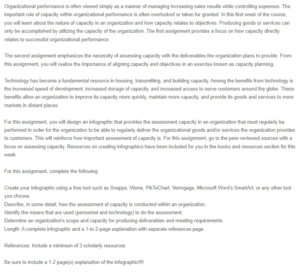Assessing Organizational Capacity
Management and leadership, change implementation and effectiveness, strategic collaborations, mission, strategy, and vision, including resource planning and internal processes, are all elements of organizational capacity that are required for good performance. Capacity assessment entails comparing anticipated capacities to actual capacities to acquire a better knowledge of potential assets and requirements, which may then be used to formulate a capacity-building strategy (Kuhl et al. 2020). It aids companies in their quest for sustainability by assisting them in becoming organizations adept at performing the activities expected to realize objectives with limited resources. A consultant digs deep within the company during an organizational assessment to evaluate strengths and weaknesses between present and intended performance. When leaders grasp the company situation from this perspective, they are better equipped to improve how the companies operate for optimum advantage (Schein & Schein, 2017). Our assignment help will hone your writing prowess for papers that will awe your professors.
The infographics explain how tools measure the overall capacity of an organization is by assessing its capacity within the five key areas which include; governance, human resource, program, organizational, and financial management. Organizational assessments are a systems science framework for analyzing a planned transformation, determining the transformation’s implications on the company, assessing the corporate entities’ responsiveness to embrace the transformation, and evaluating the employee and organization-wide risks attributed to its transformation (Gökalp & Martinez 2021). The capacity assessment process entails gathering data and assessing variables that influence organizational effectiveness to establish areas of strengths and also sectors where improvement seems possible.
The scope of carrying out the capacity assessment requires an understanding of the tangible and measurable outcomes necessary for achieving organizational objectives. The assessor must evaluate and understand planned transformation, implications of the transformation on the company, corporate entities, and their responsiveness to embrace the transformation and all potential employee and organization-wide risks attributed to transformation.
References
Kuhl, L., Van Maanen, K., & Scyphers, S. (2020). An analysis of UNFCCC-financed coastal adaptation projects: Assessing patterns of project design and contributions to adaptive capacity. World Development, 127, 104748.
Gökalp, E., & Martinez, V. (2021). Digital transformation capability maturity model enabling the assessment of industrial manufacturers. Computers in Industry, 132, 103522.
Schein, E. H., & Schein, P. (2017). Organizational culture and leadership (Third). Wiley.
ORDER A PLAGIARISM-FREE PAPER HERE
We’ll write everything from scratch
Question

Assessing Organizational Capacity
Organizational performance is often viewed simply as a manner of managing increasing sales results while controlling expenses. The important role of capacity within organizational performance is often overlooked or taken for granted. In this first week of the course, you will learn about the nature of capacity in an organization and how capacity relates to objectives. Producing goods or services can only be accomplished by utilizing the capacity of the organization. The first assignment provides a focus on how capacity directly relates to successful organizational performance.
The second assignment emphasizes the necessity of assessing capacity with the deliverables the organization plans to provide. From this assignment, you will realize the importance of aligning capacity and objectives in an exercise known as capacity planning.
Technology has become a fundamental resource in housing, transmitting, and building capacity. Among the benefits from technology is the increased speed of development, increased storage of capacity, and increased access to serve customers around the globe. These benefits allow an organization to improve its capacity more quickly, maintain more capacity, and provide its goods and services to more markets in distant places.
For this assignment, you will design an infographic that provides the assessment capacity in an organization that must regularly be performed in order for the organization to be able to regularly deliver the organizational goods and/or services the organization provides to customers. This will reinforce how important assessment of capacity is. For this assignment, go to the peer-reviewed sources with a focus on assessing capacity. Resources on creating infographics have been included for you in the books and resources section for this week.
For this assignment, complete the following:
Create your infographic using a free tool such as Snappa, Visme, PikToChart, Venngage, Microsoft Word’s SmartArt, or any other tool you choose.
Describe, in some detail, how the assessment of capacity is conducted within an organization.
Identify the means that are used (personnel and technology) to do the assessment.
Determine an organization’s scope and capacity for producing deliverables and meeting requirements.
Length: A complete infographic and a 1-to 2-page explanation with separate references page
References: Include a minimum of 3 scholarly resources
Be sure to include a 1-2 page(s) explanation of the infographic!!!!

